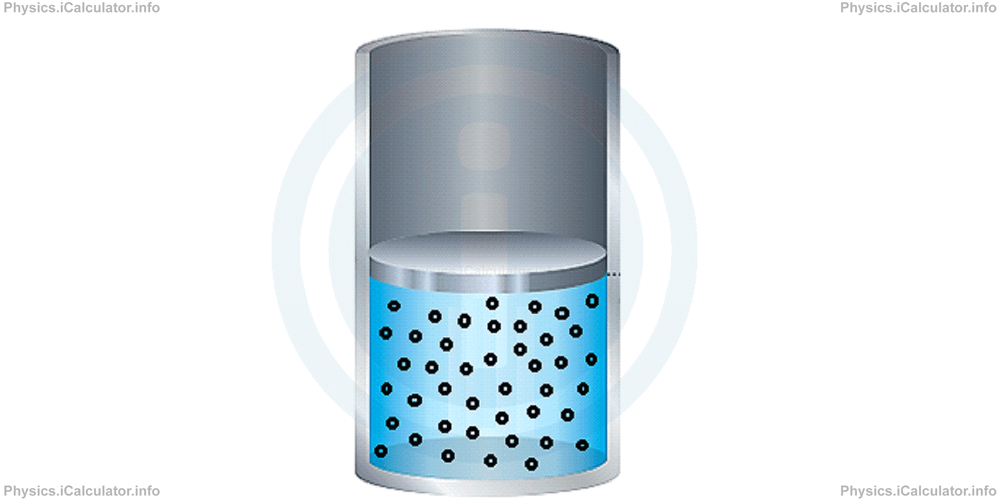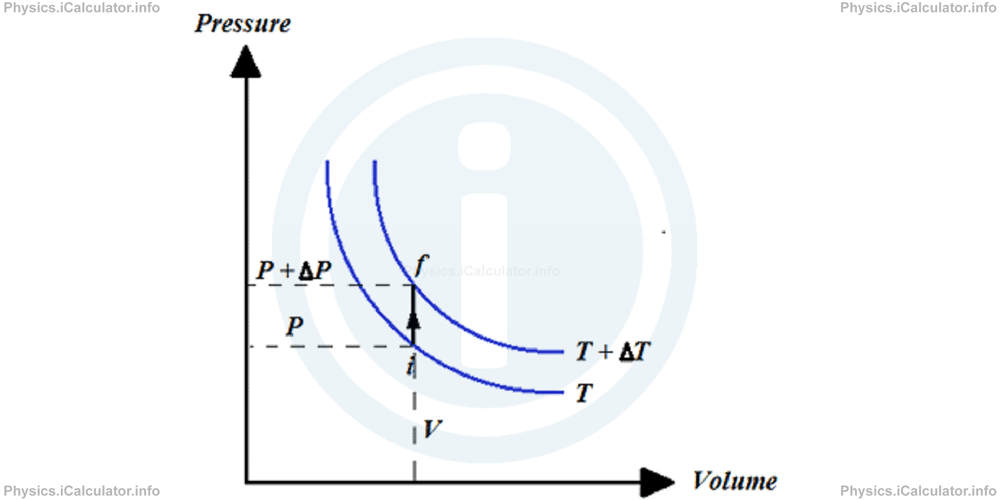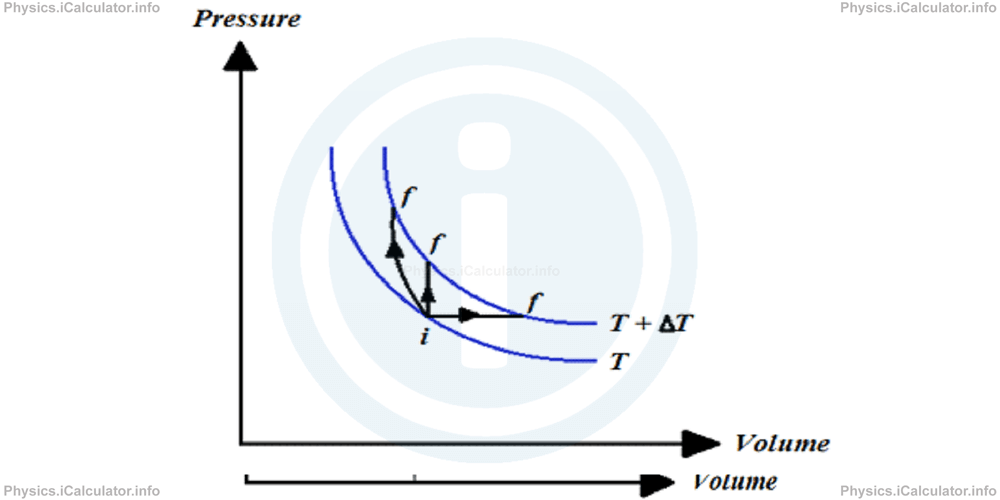Menu
Physics Lesson 13.8.2 - Molar Specific Heat at Constant Volume
Please provide a rating, it takes seconds and helps us to keep this resource free for all to use
Welcome to our Physics lesson on Molar Specific Heat at Constant Volume, this is the second lesson of our suite of physics lessons covering the topic of Molar Specific Heats and Degrees of Freedom, you can find links to the other lessons within this tutorial and access additional physics learning resources below this lesson.
Molar Specific Heat at Constant Volume
By definition, Molar specific heat of an ideal gas is the heat we provide to the gas to raise the temperature of one mole through 1K or 1°C. It differs from the specific heat capacity c discussed earlier, as the molar specific heat is calculated for 1 mole instead of 1 kg of material. We represent it as C and its unit is J mol/K.
Let's consider a gas inside a fixed cylinder, as the one shown in the figure below.

If the amount of gas inside the container is n moles, its initial temperature is T, pressure P and volume V, we consider these parameters as those of the initial state i.
If we provide a very small amount of heat energy to the gas, its temperature increases by ΔT and pressure increases by ΔP as well. Thus, the gas is brought to a final state f, which has new values for the gas parameters.
Given that volume is constant, we obtain for the P - V graph of the two states:

The heat absorbed by the gas during this process therefore is
where CV is the molar specific heat at constant volume.
From the First Law of Thermodynamics, we know that
Rearranging, we obtain
Thus, substituting the above value of Q, we obtain
Since the volume of gas is constant, there is no work done on or by the gas. Hence,
Or
Substituting
in the above equation, we obtain
Simplifying, we obtain for the molar specific heat of ideal gas
Since R = 8.31 J/K, we obtain for the value of molar specific heat of a monoatomic ideal gas:
≈ 12.5 J/mol × K
When dealing with two or more atomic gases, we observe that the motion of molecules is not that simple, as atoms in monoatomic gases, because molecules can also spin or vibrate, not only move in a translational way. Therefore, the value of CV will be greater than that obtained above for monoatomic gases.
Summarizing everything discussed above, we conclude that:
The actual internal energy of an ideal gas at constant volume is
and the change in the internal energy of an ideal gas at constant volume is
Example 1
0.3 moles of a monoatomic ideal gas are at 27°C inside a fixed container.
- What is the value of actual internal energy of this gas?
- By how many joules will the internal energy of gas increase when the temperature becomes 177°C?
- What will be the value of final internal energy of gas?
Solution 1
Clues:
n = 0.3 moles
T1 = 27°C = 27 + 273 = 300 K
T2 = 177°C = 177 + 273 = 450 K
Cv = 12.5 J/molK
Hence, we have
a) The actual (initial) internal energy of gas is
= 0.3 mol × 12.5 J/mol × K × 300 K
= 1125 J
b) Then increase in the internal energy of gas is
= 0.3 mol × 12.5 J/mol × K × (450 - 300)K
= 562.5 J
c) The value of final internal energy of gas will be
= 1125 J + 562.5 J
= 1687.5 J
The graph below shows three different paths representing three different processes that bring the ideal gas from temperature T to another temperature T + ΔT (one is at constant volume, one at constant pressure and the other is at changing volume and pressure).

It is obvious that the change in temperature is the same in all paths shown above and in many others. This means the change in internal energy is independent from the path followed during the process. Thus, we reached in a very important conclusion:
Any change in the internal energy of an ideal gas enclosed within a container depends only on the change in temperature; it is independent from the type of process that has brought that change.
You have reached the end of Physics lesson 13.8.2 Molar Specific Heat at Constant Volume. There are 4 lessons in this physics tutorial covering Molar Specific Heats and Degrees of Freedom, you can access all the lessons from this tutorial below.
More Molar Specific Heats and Degrees of Freedom Lessons and Learning Resources
Whats next?
Enjoy the "Molar Specific Heat at Constant Volume" physics lesson? People who liked the "Molar Specific Heats and Degrees of Freedom lesson found the following resources useful:
- Volume Feedback. Helps other - Leave a rating for this volume (see below)
- Thermodynamics Physics tutorial: Molar Specific Heats and Degrees of Freedom. Read the Molar Specific Heats and Degrees of Freedom physics tutorial and build your physics knowledge of Thermodynamics
- Thermodynamics Revision Notes: Molar Specific Heats and Degrees of Freedom. Print the notes so you can revise the key points covered in the physics tutorial for Molar Specific Heats and Degrees of Freedom
- Thermodynamics Practice Questions: Molar Specific Heats and Degrees of Freedom. Test and improve your knowledge of Molar Specific Heats and Degrees of Freedom with example questins and answers
- Check your calculations for Thermodynamics questions with our excellent Thermodynamics calculators which contain full equations and calculations clearly displayed line by line. See the Thermodynamics Calculators by iCalculator™ below.
- Continuing learning thermodynamics - read our next physics tutorial: Gas Laws
Help others Learning Physics just like you
Please provide a rating, it takes seconds and helps us to keep this resource free for all to use
We hope you found this Physics lesson "Molar Specific Heats and Degrees of Freedom" useful. If you did it would be great if you could spare the time to rate this physics lesson (simply click on the number of stars that match your assessment of this physics learning aide) and/or share on social media, this helps us identify popular tutorials and calculators and expand our free learning resources to support our users around the world have free access to expand their knowledge of physics and other disciplines.
Thermodynamics Calculators by iCalculator™
- Carnot Engine Efficiency Calculator
- Entropy Calculator
- Gas Laws Calculator
- Molecular Mean Free Path Calculator
- Translational Kinetic Energy Of Gas Calculator
- Root Mean Square Speed Calculator
- Ideal Gas Law Calculator
- Change In The Gas Internal Energy Calculator
- Radiative Heat Transfer Calculator
- Evaporative Heat Transfer Calculator
- Convective Heat Transfer Calculator
- Conductive Heat Transfer Calculator
- Final Temperature Of Mixture Calculator
- Heat Absorbed Or Released Calculator
- Thermal Expansion Calculator
- Temperature Calculator